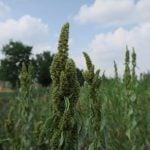Canola futures took a tumble at the end of this week as prices on the Chicago soy complex pulled back, with declines in European rapeseed and Malaysian palm oil adding to the mix. The Canadian oilseed demonstrated some independent strength as price rationing propelled values higher earlier in the week, but weakness in the other edible oils meant prices inevitably had to follow suit.
The continuing situation of ever-tightening canola supplies, coupled with a lot of uncertainty regarding this year’s crop, led the market to push prices higher. Faced with a harvest of something far less than the 20 million tonnes initially projected and tight ending stocks, the need to keep a lid on canola sales was paramount.
Read Also

Canola market sees up and down week
Canola futures endured a topsy-turvy week ended July 17, 2025, with most ICE contracts seeing net gains of about C$15 per tonne.
Although several trade guesses projected 15 million to 17 million tonnes of canola to come off of Prairie fields, some of those estimates were giving way to 14 million tonnes or less.
That picture won’t be made clearer until Statistics Canada issues its principal field crops report on Aug. 30. That survey-based report will be followed by satellite-based estimates a month later.
Until then, traders and analysts have heard anecdotal reports of single-digit yields from canola growers. The drought across the Prairies certainly has taken its toll on a crop that has a strong distaste for dry conditions.
However, the Canadian oilseed is most often a follower and not a leader on the markets. Where the soy complex goes on the Chicago Board of Trade (CBOT), especially soyoil, canola is sure to follow — albeit with a bit of a lag either way.
Over much of this week, October soyoil lost 3.67 cents per pound, which highlighted an easing global demand for veg oils. Part of that was due to increased concerns over the Delta variant of COVID-19, and part of it was the closure of one of China’s main ports because of the virus.
During that time, ICE Futures’ November canola contract fell from $912.40 per tonne at the close on Aug. 16 to $890.80 at the finish on Aug. 19. Just in the last two days of trading, November plummeted $27.50.
But canola will still need to be more expensive than other edible oils, simply because there isn’t now and won’t be enough to go around later. We could see prices push into the $900-per-tonne range, or even exceed $1,000. That will largely depend on the course set by Chicago soyoil. If it turns much stronger, then those lofty canola prices will be attainable.




















